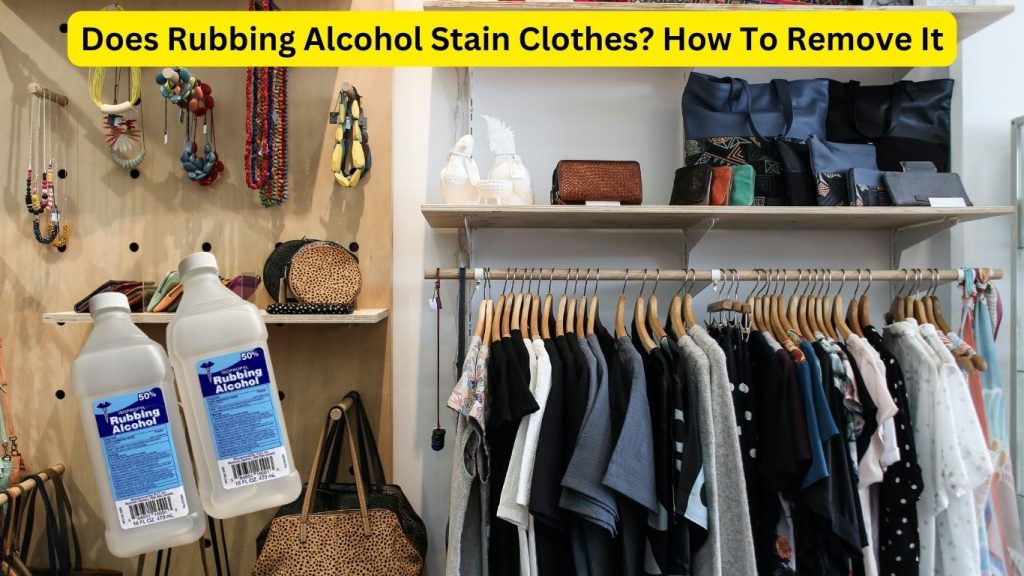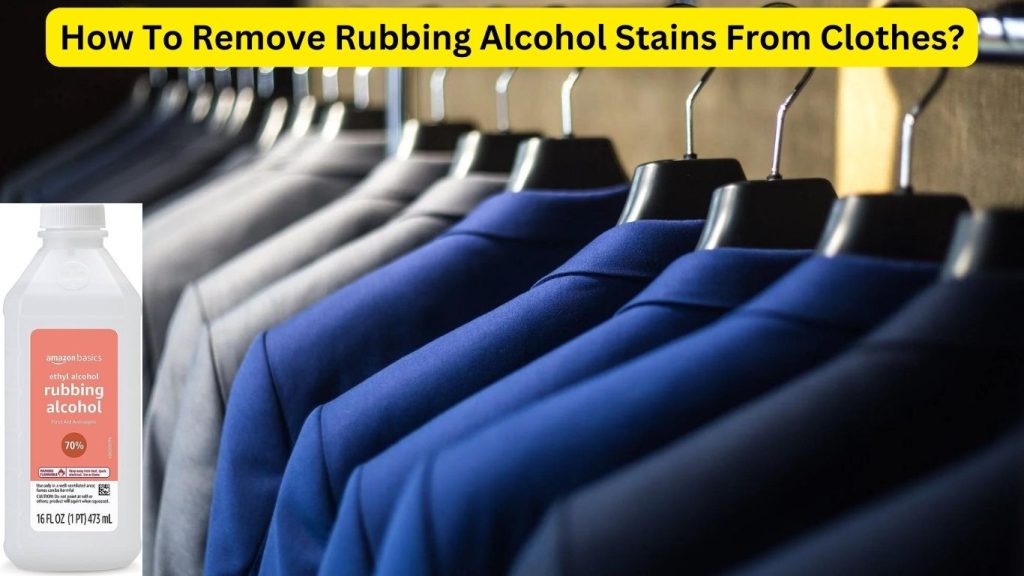Rubbing alcohol can indeed stain clothes, particularly fabrics that are sensitive or prone to discoloration. The alcohol content in rubbing alcohol can cause dyes and pigments in fabrics to dissolve or fade, leading to noticeable stains. Removing these stains requires prompt action and the right approach.

In this guide, we’ll explore effective methods to remove rubbing alcohol stains from clothes. By following these steps, you can increase the chances of successfully eliminating the stains and restoring your garments to their original condition.
Remember, the key is to act quickly and use appropriate stain-removing techniques to minimize the damage caused by rubbing alcohol.
Table of Contents
What Is Rubbing Alcohol?
Rubbing alcohol, also known as isopropyl alcohol, is a common household solvent and disinfectant. It is a colorless, flammable liquid with a strong odor. Rubbing alcohol is composed of isopropyl alcohol, water, and occasionally other additives such as stabilizers or denaturants.
It is widely used for various purposes, including disinfecting surfaces, cleaning wounds, and removing stains. Rubbing alcohol has antiseptic properties that make it effective in killing bacteria, viruses, and fungi. It evaporates quickly and leaves no residue, which makes it a popular choice for cleaning and sanitizing purposes.
However, due to its high alcohol content, it can cause stains on certain fabrics and surfaces.
Does Rubbing Alcohol Stain Clothes?
Yes, rubbing alcohol can stain clothes. The high alcohol content in rubbing alcohol can dissolve or fade dyes and pigments in fabrics, resulting in noticeable stains. This is particularly true for sensitive fabrics or those prone to discoloration.
When rubbing alcohol comes into contact with clothing, it is essential to address the stain promptly to increase the chances of successful removal. Delaying treatment can make the stain more difficult to eliminate.
By using appropriate stain-removing techniques and acting quickly, it is possible to minimize the damage caused by rubbing alcohol and restore clothes to their original condition.
Does Rubbing Alcohol Stain Come Out Of Clothes?
Removing rubbing alcohol stains from clothes is challenging, but with prompt and proper treatment, it is possible to minimize or eliminate the stain.

However, it is important to note that the success of stain removal depends on various factors such as fabric type, color, and the extent of the stain.
Acting quickly, blotting the stain, pre-treating with a stain remover, and laundering can help remove the rubbing alcohol stain.
While it may not guarantee complete removal in all cases, following these steps increases the chances of successfully getting the rubbing alcohol stain out of clothes.
How To Remove Rubbing Alcohol Stains From Clothes?

Here are three different methods you can try to remove rubbing alcohol stains from clothes:
Method 1: Dish Soap and Water
- Blot the stain: Use a clean cloth or paper towel to blot and remove any excess rubbing alcohol from the fabric.
- Mix a solution: In a bowl, combine one tablespoon of liquid dish soap with two cups of warm water.
- Apply the solution: Dip a clean cloth or sponge into the soapy water mixture and gently dab it onto the stained area. Avoid rubbing, as it may spread the stain further.
- Blot and rinse: Blot the stain with a clean cloth or sponge, then rinse the fabric under cool running water.
- Launder as usual: Wash the garment following the care instructions on the label.
Method 2: Vinegar and Water
- Blot the stain: Remove any excess rubbing alcohol by blotting it with a clean cloth or paper towel.
- Create a mixture: Mix equal parts of white vinegar and water in a bowl or spray bottle.
- Apply the solution: Moisten a clean cloth or sponge with the vinegar-water mixture and gently dab it onto the stained area.
- Blot and rinse: Blot the stain with a clean cloth or sponge, then rinse the fabric under cool running water.
- Launder as usual: Wash the garment according to the care instructions.
Method 3: Rubbing Alcohol and Stain Remover
- Test a hidden area: Before applying rubbing alcohol or stain remover, test it on a small, inconspicuous area of the fabric to ensure it doesn’t cause any damage or discoloration.
- Blot the stain: Use a clean cloth or paper towel to blot away any excess rubbing alcohol.
- Apply rubbing alcohol: Moisten a clean cloth or sponge with rubbing alcohol and gently dab it onto the stain.
- Pre-treat with stain remover: Apply a small amount of liquid stain remover directly to the stained area and gently rub it in with your fingers or a soft brush.
- Let it sit: Allow the stain remover to sit on the fabric for a few minutes, following the instructions on the product.
- Launder as usual: Wash the garment as per the care instructions provided.
Remember to always check the clothing’s care instructions and test any cleaning solution on a small, inconspicuous area of the fabric before applying it to the stain.
Does Rubbing Alcohol Bleach Clothes?
Rubbing alcohol does not typically bleach clothes. Unlike chlorine bleach, rubbing alcohol (isopropyl alcohol) does not have strong bleaching properties.
However, it is important to note that rubbing alcohol can still cause discoloration or fading on certain fabrics, especially if they are sensitive or prone to color damage. The high alcohol content in rubbing alcohol can dissolve or fade dyes and pigments, resulting in noticeable stains or changes in color.
Therefore, it is advisable to test rubbing alcohol on a small, inconspicuous area of the fabric before applying it to the entire garment. This will help ensure that the rubbing alcohol does not cause any undesirable color changes or bleaching effects.
Read Next:
Final Words
Rubbing alcohol can stain clothes, particularly fabrics that are sensitive or prone to discoloration. Prompt action is crucial when dealing with rubbing alcohol stains to increase the chances of successful removal.
While it may be challenging to completely eliminate these stains, there are effective methods to minimize their appearance.
Whether using dish soap and water, vinegar and water, or a combination of rubbing alcohol and stain remover, the key is to blot, treat, rinse, and launder the garment following the care instructions.
However, it’s important to note that prevention is always better than treatment. So, take precautions when using rubbing alcohol near clothes to avoid potential stains.
